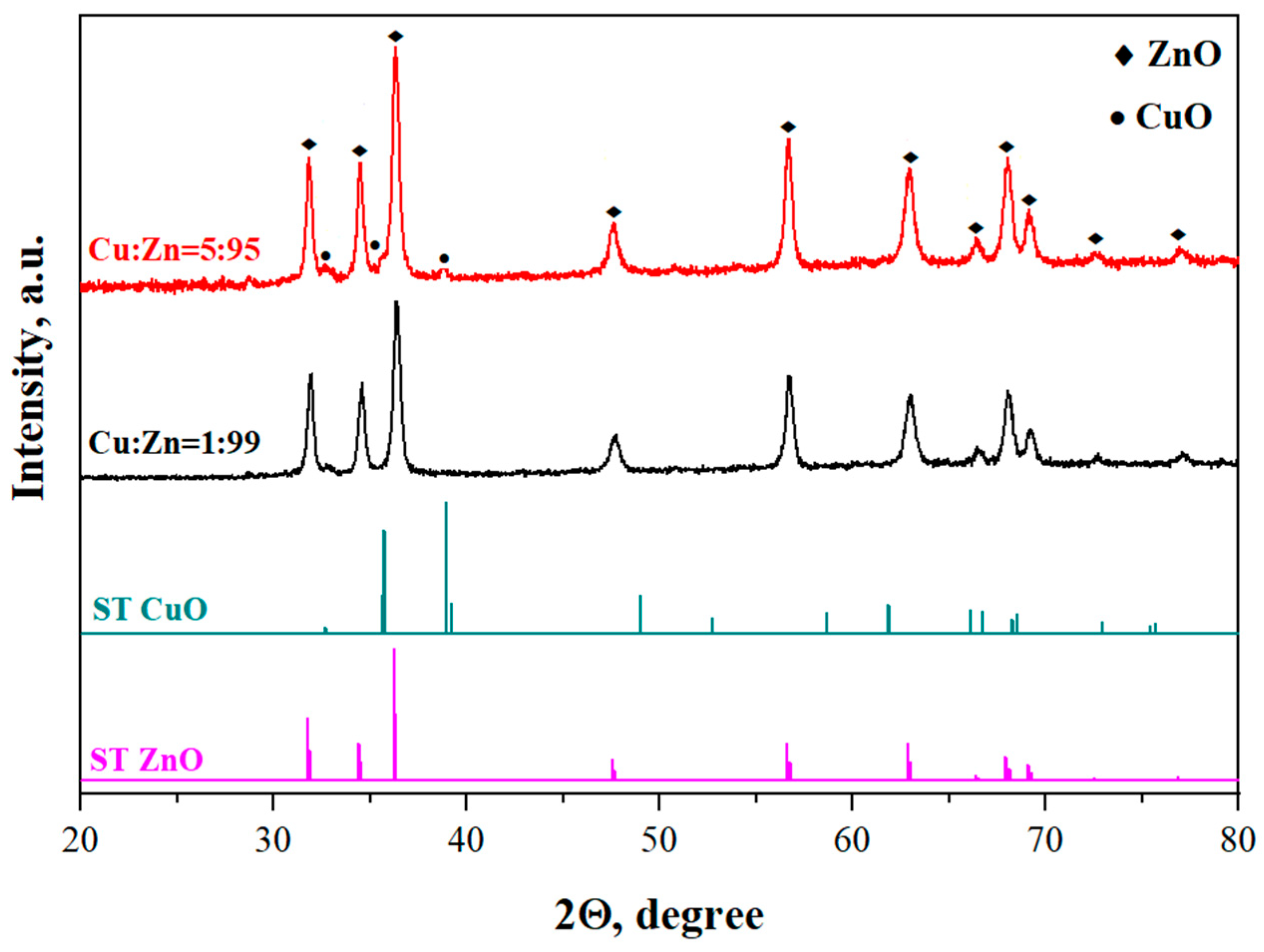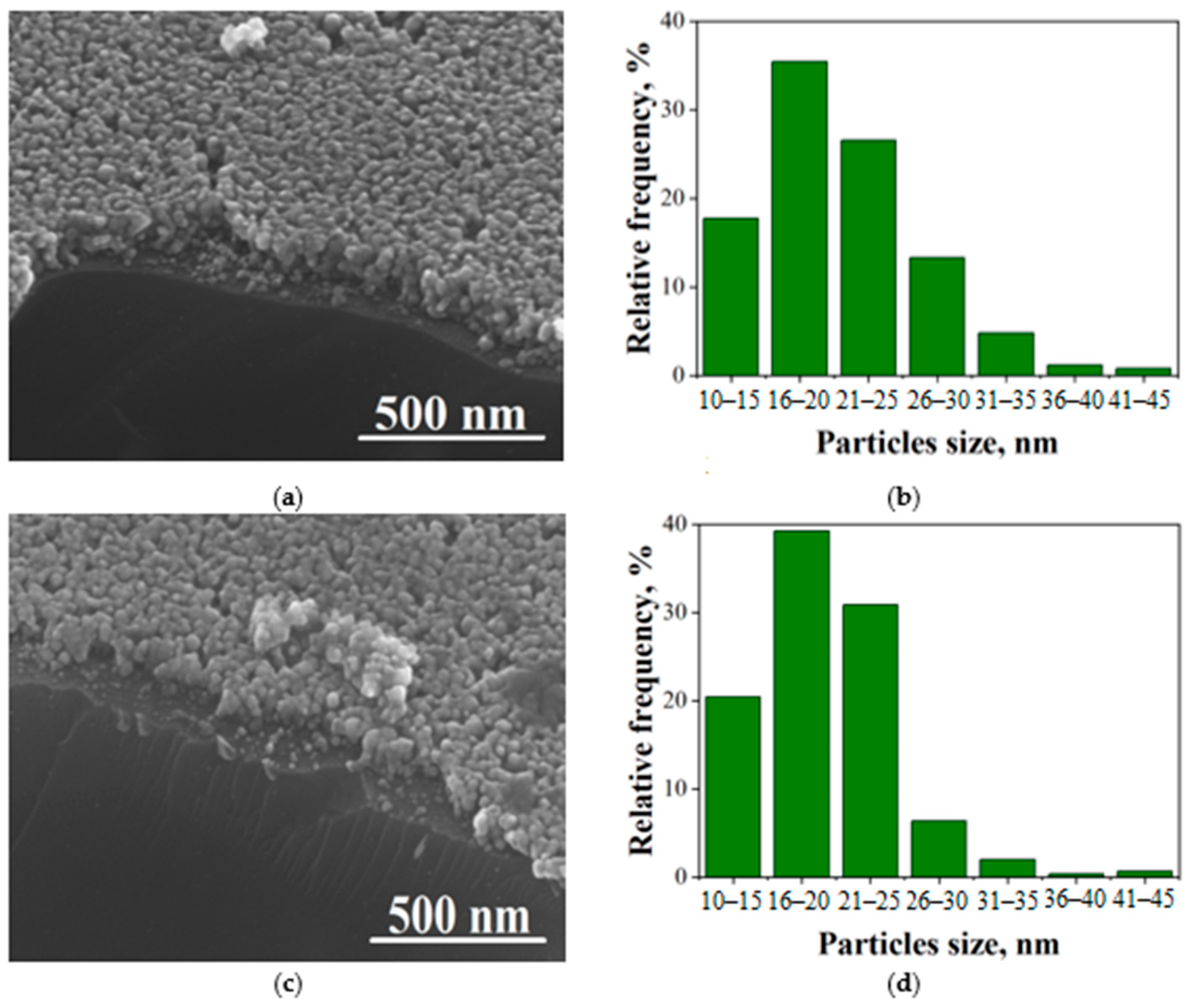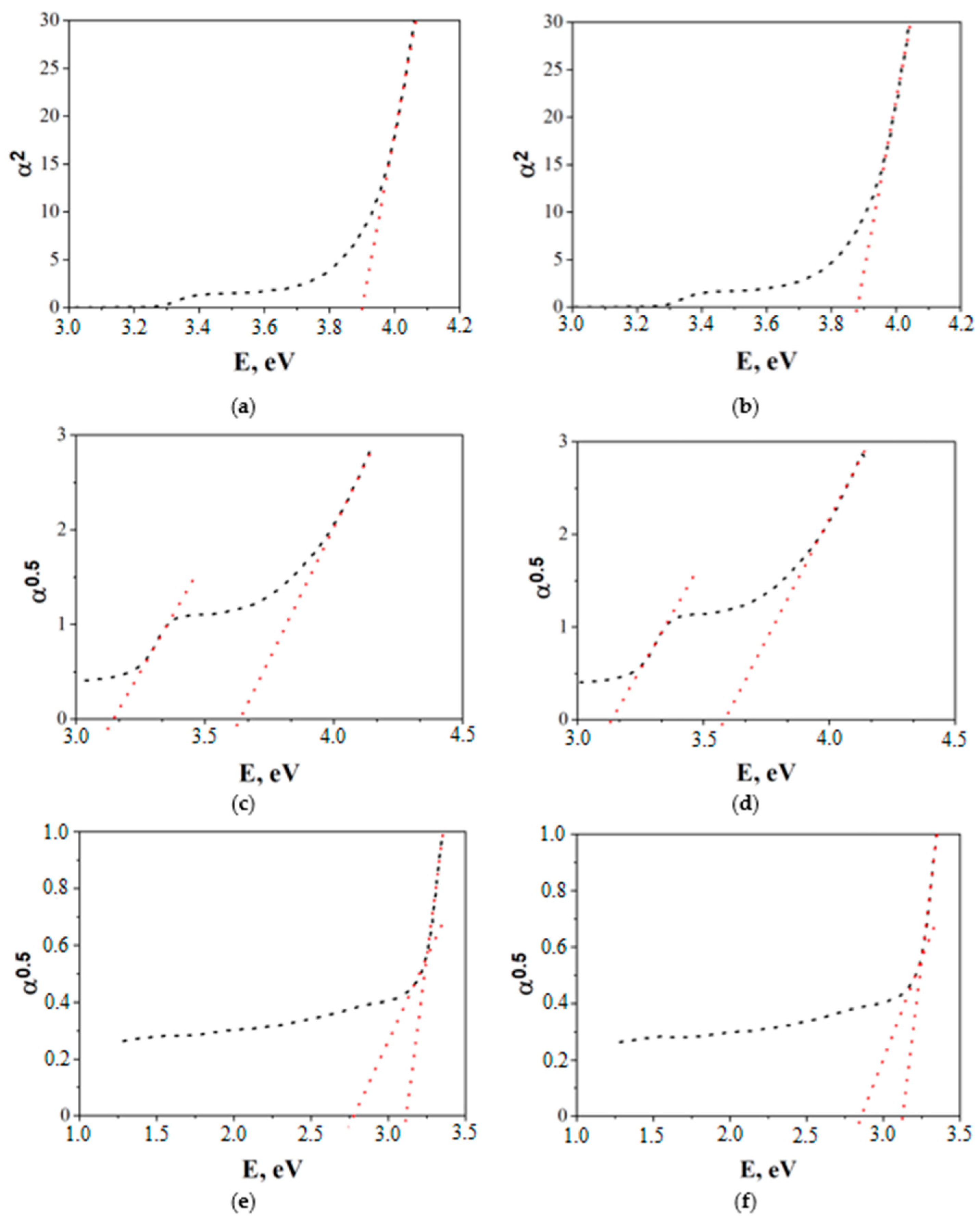Synthesis of Nanocrystalline Composite CuO-ZnO Thin Films for Photovoltaic Sensors †
Abstract
1. Introduction
2. Materials and Methods
3. Results and Discussion
3.1. XRD
3.2. SEM
3.3. Optical Properties
Author Contributions
Funding
Institutional Review Board Statement
Informed Consent Statement
Data Availability Statement
Conflicts of Interest
References
- Li, S.Q.; Yao, C.B.; Han, Y.; Jiang, G.Q.; Cai, Y.; Yin, H.T.; Sun, W.J. Synthesis, electrical and ultrafast nonlinear optical properties of Sn–ZnO composite film. Opt. Mater. 2019, 96, 109329. [Google Scholar] [CrossRef]
- Özgür, Ü.; Hofstetter, D.; Morkoc, H. ZnO devices and applications: A review of current status and future prospects. Proc. IEEE 2010, 98, 1255–1268. [Google Scholar] [CrossRef]
- Pillai, S.C.; Kelly, J.M.; Ramesh, R.; McCormack, D.E. Advances in the synthesis of ZnO nanomaterials for varistor devices. J. Mater. Chem. C 2013, 1, 3268–3281. [Google Scholar] [CrossRef]
- Wibowo, A.; Marsudi, M.A.; Amal, M.I.; Ananda, M.B.; Stephanie, R.; Ardy, H.; Diguna, L.J. ZnO nanostructured materials for emerging solar cell applications. RSC Adv. 2020, 10, 42838–42859. [Google Scholar] [CrossRef] [PubMed]
- Taabouche, A.; Bouabellou, A.; Kermiche, F.; Hanini, F.; Bouachiba, Y.; Kerdjac, T. Properties of cobalt-doped zinc oxide thin films grown by pulsed laser deposition on glass substrates. Mater. Sci. Semicond. Process. 2014, 28, 54–58. [Google Scholar] [CrossRef]
- Boukaous, C.; Benhaoua, B.; Telia, A.; Ghanem, S. Effect of copper doping sol-gel ZnO thin films: Physical properties and sensitivity to ethanol vapor. Mater. Res. Express 2017, 4, 105024. [Google Scholar] [CrossRef][Green Version]
- Sung, N.E.; Kang, S.W.; Shin, H.J.; Lee, H.K.; Lee, I.J. Cu doping effects on the electronic and optical properties of Cu-doped ZnO thin films fabricated by radio frequency sputtering. Thin Solid Film. 2013, 547, 285–288. [Google Scholar] [CrossRef]
- Muiva, C.M.; Sathiaraj, T.S.; Maabong, K. Effect of doping concentration on the properties of aluminium doped zinc oxide thin films prepared by spray pyrolysis for transparent electrode applications. Ceram. Int. 2011, 37, 555–560. [Google Scholar] [CrossRef]
- Rajan, A.; Arora, K.; Yadav, H.K.; Gupta, V.; Tomar, M. Copper doped ZnO thin film for ultraviolet photodetector with enhanced photosensitivity. MRS Online Proc. Libr. (OPL) 2013, 1494, 43–49. [Google Scholar] [CrossRef]
- Petrov, V.V.; Sysoev, V.V.; Ignatieva, I.O.; Gulyaeva, I.A.; Volkova, M.G.; Ivanishcheva, A.P.; Bayan, E.M. Nanocomposite Co3O4-ZnO thin films for photoconductivity sensors. Sensors 2023, 23, 5617. [Google Scholar] [CrossRef] [PubMed]
- Saini, M.; Singh, R.; Mitra, A.; Som, T. Photoresponse of pulsed laser deposited ZnO:Cu thin films. Sol. Energy 2020, 207, 228–234. [Google Scholar] [CrossRef]
- Petrov, V.V.; Ignatieva, I.O.; Volkova, M.G.; Gulyaeva, I.A.; Pankov, I.V.; Bayan, E.M. Polycrystalline transparent Al-doped ZnO thin films for photosensitivity and optoelectronic applications. Nanomaterials 2023, 13, 2348. [Google Scholar] [CrossRef] [PubMed]
- John, K.I.; Adenle, A.A.; Adeleye, A.T.; Onyia, I.P.; Amune-Matthews, C.; Omorogie, M.O. Unravelling the effect of crystal dislocation density and microstrain of titanium dioxide nanoparticles on tetracycline removal performance. Chem. Phys. Lett. 2021, 776, 138725. [Google Scholar] [CrossRef]
- Shalimova, K.V. Physics of Semiconductors, 2nd ed.; Energia: Moscow, Russia, 1976. [Google Scholar]
- Bayan, E.M.; Petrov, V.V.; Volkova, M.G.; Storozhenko, V.Y.; Chernyshev, A.V. SnO2–ZnO nanocomposite thin films: The influence of structure, composition and crystallinity on optical and electrophysical properties. J. Adv. Dielectr. 2021, 11, 2160008. [Google Scholar] [CrossRef]
- Ignatieva, I.O.; Volkova, M.G.; Gulyaeva, I.A.; Starnikova, A.P.; Petrov, V.V.; Bayan, E.M. The optical and electrophysical properties of Al-ZnO thin films. Mater. Today Proc. 2022, 52, 191–194. [Google Scholar] [CrossRef]
- Xu, C.X.; Sun, X.W.; Zhang, X.H.; Ke, L.; Chua, S.J. Photoluminescent properties of copper-doped zinc oxide nanowires. Nanotechnology 2004, 15, 856–861. [Google Scholar] [CrossRef]



| Composition | Δ × 10−3 (nm−2) | Ε × 10−3 |
|---|---|---|
| Cu:Zn = 1:99 | 2.09 | 5.27 |
| Cu:Zn = 5:95 | 1.81 | 4.90 |
Disclaimer/Publisher’s Note: The statements, opinions and data contained in all publications are solely those of the individual author(s) and contributor(s) and not of MDPI and/or the editor(s). MDPI and/or the editor(s) disclaim responsibility for any injury to people or property resulting from any ideas, methods, instructions or products referred to in the content. |
© 2025 by the authors. Licensee MDPI, Basel, Switzerland. This article is an open access article distributed under the terms and conditions of the Creative Commons Attribution (CC BY) license (https://creativecommons.org/licenses/by/4.0/).
Share and Cite
Ignatieva, I.O.; Petrov, V.V.; Bayan, E.M. Synthesis of Nanocrystalline Composite CuO-ZnO Thin Films for Photovoltaic Sensors. Eng. Proc. 2024, 82, 110. https://doi.org/10.3390/ecsa-11-22210
Ignatieva IO, Petrov VV, Bayan EM. Synthesis of Nanocrystalline Composite CuO-ZnO Thin Films for Photovoltaic Sensors. Engineering Proceedings. 2024; 82(1):110. https://doi.org/10.3390/ecsa-11-22210
Chicago/Turabian StyleIgnatieva, Irina O., Victor V. Petrov, and Ekaterina M. Bayan. 2024. "Synthesis of Nanocrystalline Composite CuO-ZnO Thin Films for Photovoltaic Sensors" Engineering Proceedings 82, no. 1: 110. https://doi.org/10.3390/ecsa-11-22210
APA StyleIgnatieva, I. O., Petrov, V. V., & Bayan, E. M. (2024). Synthesis of Nanocrystalline Composite CuO-ZnO Thin Films for Photovoltaic Sensors. Engineering Proceedings, 82(1), 110. https://doi.org/10.3390/ecsa-11-22210






